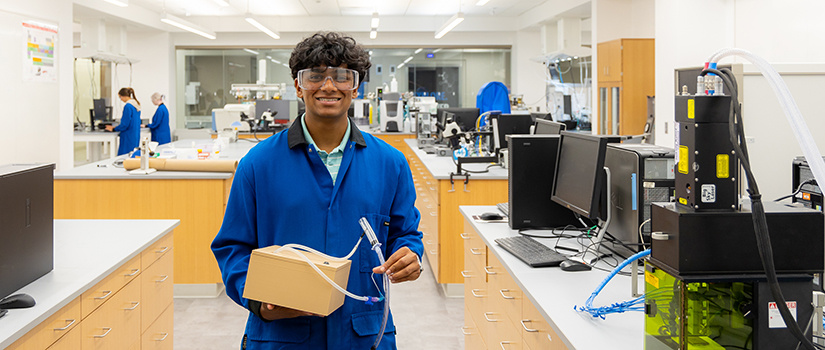When he was in the tenth grade, Shrihan Ganesh Babu attended a premedical conference where he got to insert a breathing tube into a mannequin. This common ICU procedure, called intubation, saves millions of lives each year – but it comes with a risk.
As Ganesh Babu guided the flexible tube into the airway of the model, his instructor explained how easy it is to injure a human patient during the procedure.
“That really got me thinking,” Ganesh Babu says. “I went home and started looking into the statistics, and more than half of all patients who get intubated get some kind injury, whether that is irritation or something more serious.”
Now a freshman and biochemistry major at the University of South Carolina, Ganesh Babu spent the last two years of high school researching how to reduce injuries caused by intubation. His idea recently helped him win a national research competition.
Ganesh Babu’s says intubation injury seems to occur because of variations in the pressure within a patient’s airway. To fit comfortably, the breathing tube needs to form a tight seal in the patient’s trachea, which naturally expands and contracts with every breath.
This means that with every inhale and exhale, the pressure of the breathing tube inside the patient’s throat may be too high and then too low, again and again.
“I thought ‘There has to be a better way,’” Ganesh Babu says, “I started learning all I could about endotracheal tubes and worked with my high school engineering teacher to design a more responsive, dynamic way to control the pressure and decrease the chances of those injuries.”
He participated in a magnet program at Spring Valley High School that gave him support and mentorship all through his research project. In addition to his teachers, he consulted with a doctor and medical researcher to ensure his design would be practical in a hospital setting.
As a result, he has prototyped a working device, which attaches to a standard breathing tube and may be able to modulate the pressure and help reduce injury to the patient’s soft tissues. He hopes USC will help to take his research to the next level and make his design a reality for future patients.
"My prototype is simple but fully functioning. The issue is that as a high school student, there were limitations in testing it,” Ganesh Babu says.
“At USC, I want to revamp the design using better materials, but the next step for me will be finding a mentor here to continue my research, possibly finding an investor, and then taking it further to test the device.”
Ganesh Babu has won awards at multiple competitions for his research project, including the USC-hosted regional Junior Science Honors Symposium in 2024.
He and several other students from the USC competition then traveled to nationals in New Mexico, where Ganesh Babu won first place in oral presentation in the engineering and technology category. He won a scholarship that he plans to use to help fund his research going forward.
Ganesh Babu says competitions like the Junior Science Honors Symposium can be a rewarding experience for students because of the supportive environment.
“You get to talk with the judges who ask you good questions and also give you suggestions on how to improve your research for next time,” he says.
“You also get to meet a lot of like-minded people. Some of my closest friends are people I've met at conferences. And you get to talk to professors and experts in your field.”
Ganesh Babu is an Honors College student and one of USC’s Top Scholars, a program that prepares students for graduate school or a career through high-impact activities like research, volunteering, internships and leadership.
Thanks to the experiences early in his academic career, a future in medical research or emergency medicine is within reach for Ganesh Babu. Perhaps both.
“I'm considering pursuing a Ph.D. in medicine which would allow me continue doing research on the side while also being physician,” he says.
Whichever career path he chooses, he's on track to make a difference for patients through his research, while also making an impact by volunteering at the Veteran’s Affairs Hospital, shadowing in the ER and earning an EMT license.
“As a doctor, you have the opportunity to change people's lives. People present with different cases, different symptoms. It’s almost like investigative work with many variables to consider. And you get to help people,” he says.
